
Archimate Business Layer Active Components
Business Layer Active Components
- The active structure aspect of the Business Layer refers to the static structure of an organization.
- Entities that make up the organization and their relationships
- Are the subjects (e.g., business actors or business roles) that perform behavior such as business processes or functions (capabilities)
The Below Diagram represents all the Active Components for the Business Layer
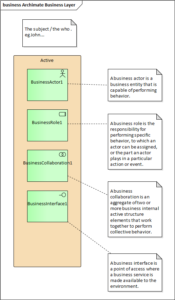
Description of Active Components
Each Active Component Element will be described in the next section
Business Actors
Definition : A business actor is a business entity that is capable of performing behavior.
Characteristics : Business actors may be individual persons.but also groups of people. and resources that have a permanent. status within the organizations. Typical examples of the latter are a department and a business unit. Examples of business actors are humans, departments, and business units.
Naming Standard : The name of a business actor should preferably be a noun
Business Actor Meta Model

Business Actor Applied Example
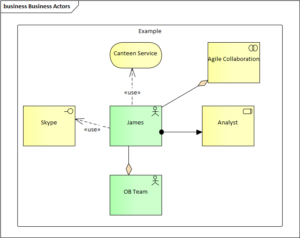
Business Role
Definition : A business role is the responsibility for performing specific behavior, to which an actor can be assigned, or the part an actor plays in a particular action or event.
Characteristics : Business roles with certain responsibilities or skills are assigned to business processes or business functions. A business actor that is assigned to a business role is responsible that the corresponding behavior is carried out, either by performing it or by delegating and managing its performance. business role is also useful in a (structural) organizational sense; for instance, in the division of labor within an organization.
Naming Standard : preferably be a noun
Business Role MetaModel

Business Role Applied Example
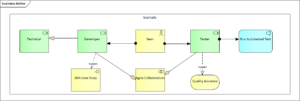
Business Collaboration
Definition : an aggregate of two or more business internal active structure elements that work together to perform collective behavior.
Characteristics: a collaboration of two or more business roles results in collective behavior which may be more than simply the sum of the behavior of the separate roles. Business collaborations represent this collective effort. Business interactions are used to describe the internal behavior that takes place within business collaboration . collaboration is a (possibly temporary) collection of business roles or actors within an organization. a business collaboration need not have an official (permanent) status within the organization
Naming Standards : should preferably be a noun. It is also rather common to leave a business collaboration unnamed.
Business Collaboration MetaModel
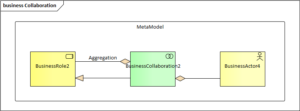
Business Collaboration Applied Example

Business Interface
Definition : A business interface is a point of access where a business service is made available to the environment.
Characteristics: is a point of access where a business service is made available to the environment. It is a point of actual contact. It could be physical, like talking to a salesperson in a shop. Or perhaps nowadays it is by means of phone or web (both examples of “channels”). Can be a provided or required interface. The same business service may be exposed through different interfaces.
Naming Standards: Should be named as a noun.
Business Interface MetaModel
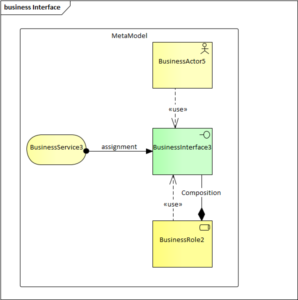
Business Interface Applied Examples
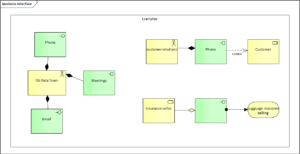
Business Layer Active Components Example

Interpretation:
The OB Data Team (Actor) consists of the individuals (James, Carl,Evert,Sean …. Actors). Association Type (Actor to Actor = Composition)
Outside parties interface with theOBData Team (Actor) via the channels Email, Phone, Meetings , Qlikview (Interfaces) . Association type (Interface to Actor = Composition)
Each Person in the team (Actor) is allocated to one or more roles (Role) for example Sean = Developer & Tester, Ben = Product Owner …. Association Type (Actor to Role = Assignment)
Each Role can further be conceptually rolled up in this case BA and Product owner = Business Focused , Dev and Testing = Technical (Role). Association Type (Role to Role = Specialisation)
The Specialised Roles (Technical and Business Focused) collaborate together via the Agile Methodology to produce output (Collaboration). Association type = Role to Collaboration = Aggregation